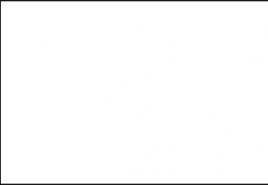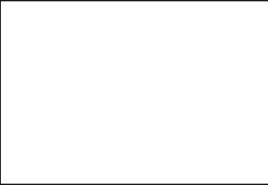Area of a triangle 2. Area of a triangle
Sometimes in life there are situations when you have to delve into your memory in search of long-forgotten school knowledge. For example, you need to determine the area of a land plot of a triangular shape, or the turn of the next repair in an apartment or a private house has come, and you need to calculate how much material it will take for a surface with a triangular shape. There was a time when you could solve such a problem in a couple of minutes, and now you are desperately trying to remember how to determine the area of a triangle?
You don't have to worry about this! After all, it is quite normal when the human brain decides to shift long-unused knowledge somewhere in a remote corner, from which it is sometimes not so easy to extract it. So that you do not have to suffer with the search for forgotten school knowledge to solve such a problem, this article contains various methods, which make it easy to find the desired area of the triangle.
It is well known that a triangle is a type of polygon that is limited by the minimum possible number of sides. In principle, any polygon can be divided into several triangles by connecting its vertices with segments that do not intersect its sides. Therefore, knowing the triangle, you can calculate the area of almost any figure.
Among all the possible triangles that occur in life, the following particular types can be distinguished: and rectangular.
The easiest way to calculate the area of a triangle is when one of its corners is right, that is, in the case of a right triangle. It is easy to see that it is half a rectangle. Therefore, its area is equal to half the product of the sides, which form a right angle between them.
If we know the height of a triangle, lowered from one of its vertices to the opposite side, and the length of this side, which is called the base, then the area is calculated as half the product of the height and the base. This is written using the following formula:
S = 1/2*b*h, in which
S is the desired area of the triangle;
b, h - respectively, the height and base of the triangle.
It is so easy to calculate the area of an isosceles triangle, since the height will bisect the opposite side, and it can be easily measured. If the area is determined, then it is convenient to take the length of one of the sides forming a right angle as the height.
All this is certainly good, but how to determine whether one of the corners of a triangle is right or not? If the size of our figure is small, then you can use a building angle, a drawing triangle, a postcard or other object with a rectangular shape.
But what if we have a triangular land plot? In this case, proceed as follows: count from the top of the proposed right angle on one side, a distance multiple of 3 (30 cm, 90 cm, 3 m), and on the other side, a distance multiple of 4 (40 cm, 160 cm, 4 m) is measured in the same proportion. Now you need to measure the distance between the end points of these two segments. If the value is a multiple of 5 (50 cm, 250 cm, 5 m), then it can be argued that the angle is right.
If the value of the length of each of the three sides of our figure is known, then the area of \u200b\u200bthe triangle can be determined using Heron's formula. In order for it to have a simpler form, a new value is used, which is called the semi-perimeter. This is the sum of all the sides of our triangle, divided in half. After the semi-perimeter is calculated, you can begin to determine the area using the formula:
S = sqrt(p(p-a)(p-b)(p-c)), where
square- Square root;
p is the value of the semi-perimeter (p =(a+b+c)/2);
a, b, c - edges (sides) of the triangle.
But what if the triangle has irregular shape? There are two possible ways here. The first of these is to try to divide such a figure into two right triangle, the sum of the areas of which is calculated separately, and then added. Or, if the angle between the two sides and the size of these sides are known, then apply the formula:
S = 0.5 * ab * sinC, where
a,b - sides of the triangle;
c is the angle between these sides.
The latter case is rare in practice, but nevertheless, everything is possible in life, so the above formula will not be superfluous. Good luck with your calculations!
Area of a triangle. In many geometry problems related to the calculation of areas, formulas for the area of a triangle are used. There are several of them, here we will consider the main ones.To list these formulas would be too simple and useless. We will analyze the origin of the main formulas, those that are used most often.
Before you familiarize yourself with the derivation of formulas, be sure to look at the article on.After studying the material, you can easily restore the formulas in memory (if they suddenly "fly out" at the right time for you).
First formula
The diagonal of a parallelogram divides it into two triangles of equal area:

Therefore, the area of the triangle will be equal to half the area of the parallelogram:

Triangle area formula
* That is, if we know any side of the triangle and the height lowered to this side, then we can always calculate the area of \u200b\u200bthis triangle.
Formula Two
As already stated in the article on the area of a parallelogram, the formula has the form:

The area of a triangle is half its area, so:

*That is, if any two sides in a triangle and the angle between them are known, we can always calculate the area of such a triangle.
Heron's formula (third)

This formula is difficult to derive and you do not need it. Look how beautiful she is, we can say that she is remembered.
*If three sides of a triangle are given, then using this formula we can always calculate its area.
Formula Four

Where ris the radius of the inscribed circle
*If three sides of a triangle and the radius of the circle inscribed in it are known, then we can always find the area of this triangle.
Formula five

Where Ris the radius of the circumscribed circle.
*If three sides of a triangle and the radius of the circumscribed circle are known, then we can always find the area of such a triangle.
The question arises: if three sides of a triangle are known, then is it not easier to find its area using Heron's formula!
Yes, it is easier, but not always, sometimes it becomes difficult. It has to do with root extraction. In addition, these formulas are very convenient to use in problems where the area of a triangle is given, its sides are given and it is required to find the radius of an inscribed or circumscribed circle. Such tasks are included in the exam.
Let's take a look at the formula:

It is a special case of the formula for the area of a polygon in which a circle is inscribed:
Consider it on the example of a pentagon:

We connect the center of the circle with the vertices of this pentagon and drop perpendiculars from the center to its sides. We get five triangles, with the dropped perpendiculars being the radii of the inscribed circle:

The area of the pentagon is:

Now it is clear that if we are talking about a triangle, then given formula takes the form:

Formula six
Area formula is necessary to determine the area of a figure, which is a real-valued function defined on a certain class of figures in the Euclidean plane and satisfying 4 conditions:
- Positive - Area cannot be less than zero;
- Normalization - a square with a side of unity has an area of 1;
- Congruence - congruent figures have equal area;
- Additivity - the area of the union of 2 shapes without common interior points is equal to the sum of the areas of these shapes.
| Geometric figure | Formula | Drawing |
|---|---|---|
|
The result of adding the distances between the midpoints opposite sides convex quadrilateral will be equal to its semiperimeter. |
||
|
Circle sector. The area of a sector of a circle is equal to the product of its arc and half the radius. |
|
|
|
circle segment. To get the area of segment ASB, it is enough to subtract the area of triangle AOB from the area of sector AOB. |
S = 1 / 2 R(s - AC) |
|
|
The area of an ellipse is equal to the product of the lengths of the major and minor semiaxes of the ellipse times pi. |
|
|
|
Ellipse. Another option how to calculate the area of an ellipse is through its two radii. |
|
|
|
Triangle. Through base and height. The formula for the area of a circle in terms of its radius and diameter. |
||
|
Square . Through his side. The area of a square is equal to the square of the length of its side. |
|
|
|
Square. Through its diagonal. The area of a square is half the square of the length of its diagonal. |
||
|
regular polygon. To determine the area of a regular polygon, it is necessary to divide it into equal triangles that would have a common vertex at the center of the inscribed circle. |
S= r p = 1/2 r n a |
The triangle is geometric figure, which consists of three lines joining at points that do not lie on the same line. The connection points of the lines are the vertices of the triangle, which are denoted by Latin letters (for example, A, B, C). The connecting straight lines of a triangle are called segments, which are also usually denoted in Latin letters. There are the following types of triangles:
- Rectangular.
- obtuse.
- Acute-angled.
- Versatile.
- Equilateral.
- Isosceles.
General formulas for calculating the area of a triangle
Triangle area formula for length and height
S=a*h/2,
where a is the length of the side of the triangle whose area is to be found, h is the length of the height drawn to the base.
Heron's formula
S=√p*(p-a)*(p-b)*(p-c),
where √ is the square root, p is the semiperimeter of the triangle, a,b,c is the length of each side of the triangle. The semiperimeter of a triangle can be calculated using the formula p=(a+b+c)/2.


The formula for the area of a triangle in terms of the angle and length of the segment
S = (a*b*sin(α))/2,
Where b,c is the length of the sides of the triangle, sin (α) is the sine of the angle between the two sides.


The formula for the area of a triangle given the radius of the inscribed circle and three sides
S=p*r,
where p is the semiperimeter of the triangle whose area is to be found, r is the radius of the circle inscribed in this triangle.


The formula for the area of a triangle given three sides and the radius of a circle circumscribed around it
S= (a*b*c)/4*R,
where a,b,c is the length of each side of the triangle, R is the radius of the circumscribed circle around the triangle.


The formula for the area of a triangle in Cartesian coordinates of points
The Cartesian coordinates of points are coordinates in the xOy system, where x is the abscissa and y is the ordinate. The Cartesian coordinate system xOy on a plane is called mutually perpendicular numerical axes Ox and Oy with a common reference point at point O. If the coordinates of points on this plane are given in the form A (x1, y1), B (x2, y2) and C (x3, y3 ), then you can calculate the area of a triangle using the following formula, which is obtained from the cross product of two vectors.
S = |(x1 – x3) (y2 – y3) – (x2 – x3) (y1 – y3)|/2,
where || stands for module.


How to find the area of a right triangle
A right triangle is a triangle that has one angle of 90 degrees. A triangle can have only one such angle.
The formula for the area of a right triangle on two legs
S=a*b/2,
where a,b is the length of the legs. The legs are called the sides adjacent to the right angle.


The formula for the area of a right triangle given the hypotenuse and acute angle
S = a*b*sin(α)/ 2,
where a, b are the legs of the triangle, and sin(α) is the sine of the angle at which the lines a, b intersect.


The formula for the area of a right triangle by leg and opposite angle
S = a*b/2*tg(β),
where a, b are the legs of the triangle, tg(β) is the tangent of the angle at which the legs a, b are connected.


How to calculate the area of an isosceles triangle
An isosceles triangle is one that has two equal sides. These sides are called the sides and the other side is the base. You can use one of the following formulas to calculate the area of an isosceles triangle.
The basic formula for calculating the area of an isosceles triangle
S=h*c/2,
where c is the base of the triangle, h is the height of the triangle lowered to the base.


Formula of an isosceles triangle on the lateral side and base
S=(c/2)* √(a*a – c*c/4),
where c is the base of the triangle, a is the value of one of the sides of the isosceles triangle.


How to find the area of an equilateral triangle
An equilateral triangle is a triangle in which all sides are equal. To calculate the area of an equilateral triangle, you can use the following formula:
S = (√3*a*a)/4,
where a is the length of the side of an equilateral triangle.


The above formulas will allow you to calculate the required area of \u200b\u200bthe triangle. It is important to remember that in order to calculate the spacing of triangles, one must take into account the type of triangle and the available data that can be used for the calculation.
The triangle is a well-known figure. And this, despite rich variety its forms. Rectangular, equilateral, acute, isosceles, obtuse. Each of them is somewhat different. But for any it is required to know the area of the triangle.
Common formulas for all triangles that use the lengths of the sides or heights
The designations adopted in them: sides - a, b, c; heights on the corresponding sides on a, n in, n s.
1. The area of a triangle is calculated as the product of ½, the side and the height lowered onto it. S = ½ * a * n a. Similarly, one should write formulas for the other two sides.
2. Heron's formula, in which the semi-perimeter appears (it is customary to denote it with a small letter p, in contrast to the full perimeter). The semi-perimeter must be calculated as follows: add up all the sides and divide them by 2. The semi-perimeter formula: p \u003d (a + b + c) / 2. Then the equality for the area of \u200b\u200bthe figure looks like this: S \u003d √ (p * (p - a) * ( p - c) * (p - c)).
3. If you do not want to use a semi-perimeter, then such a formula will come in handy, in which only the lengths of the sides are present: S \u003d ¼ * √ ((a + b + c) * (b + c - a) * (a + c - c) * (a + b - c)). It is somewhat longer than the previous one, but it will help out if you forgot how to find the semi-perimeter.
General formulas in which the angles of a triangle appear
The notation that is required to read the formulas: α, β, γ - angles. They lie opposite sides a, b, c, respectively.
1. According to it, half the product of two sides and the sine of the angle between them is equal to the area of the triangle. That is: S = ½ a * b * sin γ. The formulas for the other two cases should be written in a similar way.
2. The area of a triangle can be calculated from one side and three known angles. S \u003d (a 2 * sin β * sin γ) / (2 sin α).
3. There is another formula with one known party and two adjacent corners. It looks like this: S = c 2 / (2 (ctg α + ctg β)).
The last two formulas are not the simplest. It's pretty hard to remember them.

General formulas for the situation when the radii of inscribed or circumscribed circles are known
Additional designations: r, R — radii. The first is used for the radius of the inscribed circle. The second is for the one described.
1. The first formula by which the area of a triangle is calculated is related to the semi-perimeter. S = r * r. In another way, it can be written as follows: S \u003d ½ r * (a + b + c).
2. In the second case, you will need to multiply all the sides of the triangle and divide them by the quadruple radius of the circumscribed circle. In literal terms, it looks like this: S \u003d (a * b * c) / (4R).
3. The third situation allows you to do without knowing the sides, but you need the values of all three angles. S \u003d 2 R 2 * sin α * sin β * sin γ.

Special case: right triangle
This is the simplest situation, since only the length of both legs is required. They are denoted by the Latin letters a and b. The area of a right triangle is equal to half the area of the rectangle added to it.
Mathematically, it looks like this: S = ½ a * b. She is the easiest to remember. Because it looks like the formula for the area of a rectangle, only a fraction appears, denoting half.
Special case: isosceles triangle
Since its two sides are equal, some formulas for its area look somewhat simplified. For example, Heron's formula, which calculates the area of an isosceles triangle, takes the following form:
S = ½ in √((a + ½ in)*(a - ½ in)).

If you convert it, it will become shorter. In this case, Heron's formula for an isosceles triangle is written as follows:
S = ¼ in √(4 * a 2 - b 2).
Somewhat simpler than for an arbitrary triangle, the area formula looks like if you know sides and the angle between them. S \u003d ½ a 2 * sin β.
Special case: equilateral triangle
Usually, in problems about him, the side is known or can be somehow recognized. Then the formula for finding the area of such a triangle is as follows:
S = (a 2 √3) / 4.

Tasks for finding the area if the triangle is depicted on checkered paper
The simplest situation is when a right-angled triangle is drawn so that its legs coincide with the lines of the paper. Then you just need to count the number of cells that fit into the legs. Then multiply them and divide by two.
When the triangle is acute or obtuse, it must be drawn to a rectangle. Then in the resulting figure there will be 3 triangles. One is the one given in the task. And the other two are auxiliary and rectangular. The areas of the last two must be determined by the method described above. Then calculate the area of the rectangle and subtract from it those calculated for the auxiliary ones. The area of the triangle is determined.
Much more difficult is the situation in which none of the sides of the triangle coincides with the lines of the paper. Then it must be inscribed in a rectangle so that the vertices of the original figure lie on its sides. In this case, there will be three auxiliary right triangles.

An example of a problem on Heron's formula
Condition. Some triangle has sides. They are equal to 3, 5 and 6 cm. You need to find out its area.
Now you can calculate the area of a triangle using the above formula. Under the square root is the product of four numbers: 7, 4, 2 and 1. That is, the area is √ (4 * 14) = 2 √ (14).
If you do not need more precision, then you can take the square root of 14. It is 3.74. Then the area will be equal to 7.48.
Answer. S \u003d 2 √14 cm 2 or 7.48 cm 2.
An example of a problem with a right triangle
Condition. One leg of a right-angled triangle is 31 cm longer than the second. It is required to find out their lengths if the area of the triangle is 180 cm 2.
Solution. You have to solve a system of two equations. The first has to do with area. The second is with the ratio of the legs, which is given in the problem.
180 \u003d ½ a * b;
a \u003d b + 31.
First, the value of "a" must be substituted into the first equation. It turns out: 180 \u003d ½ (in + 31) * in. It has only one unknown quantity, so it is easy to solve. After opening the brackets, a quadratic equation is obtained: in 2 + 31 in - 360 \u003d 0. It gives two values \u200b\u200bfor "in": 9 and - 40. The second number is not suitable as an answer, since the length of the side of the triangle cannot be a negative value.
It remains to calculate the second leg: add 31 to the resulting number. It turns out 40. These are the quantities sought in the problem.
Answer. The legs of the triangle are 9 and 40 cm.
The task of finding the side through the area, side and angle of a triangle
Condition. The area of some triangle is 60 cm2. It is necessary to calculate one of its sides if the second side is 15 cm, and the angle between them is 30º.
Solution. Based on the accepted designations, the desired side is “a”, the known “b”, the given angle is “γ”. Then the area formula can be rewritten as follows:
60 \u003d ½ a * 15 * sin 30º. Here the sine of 30 degrees is 0.5.
After transformations, "a" turns out to be equal to 60 / (0.5 * 0.5 * 15). That is 16.
Answer. The desired side is 16 cm.
The problem of a square inscribed in a right triangle
Condition. The vertex of a square with a side of 24 cm coincides with the right angle of the triangle. The other two lie on the legs. The third belongs to the hypotenuse. The length of one of the legs is 42 cm. What is the area of a right triangle?
Solution. Consider two right triangles. The first one is specified in the task. The second one is based on the known leg of the original triangle. They are similar because they have a common angle and are formed by parallel lines.
Then the ratios of their legs are equal. The legs of the smaller triangle are 24 cm (side of the square) and 18 cm (given leg 42 cm minus the side of the square 24 cm). The corresponding legs of the large triangle are 42 cm and x cm. It is this "x" that is needed in order to calculate the area of the triangle.
18/42 \u003d 24 / x, that is, x \u003d 24 * 42 / 18 \u003d 56 (cm).
Then the area is equal to the product of 56 and 42, divided by two, that is, 1176 cm 2.
Answer. The desired area is 1176 cm 2.










